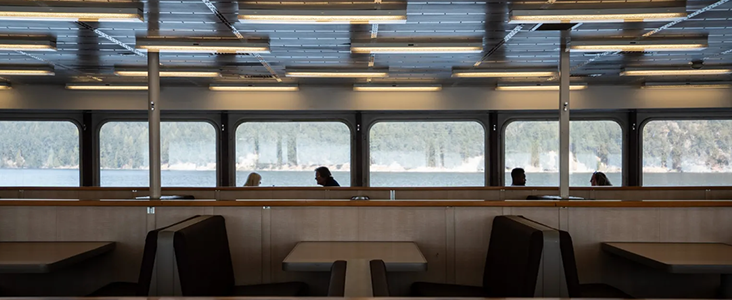||| FROM ALEX MACLEOD, SEATTLE TIMES |||
Delayed sailings of Washington State Ferries hit an all-time high this year, as The Seattle Times recently reported, part of a steady decline in performance over the past decade. [“WA ferry delays hit highest mark in past decade,” Aug. 24, Northwest]. The fleet is smaller than ever, with virtually no boats available when backup is needed, and those still running are less mechanically reliable than ever.
By far the worst performance record is in the San Juan Islands, where ferries are the county’s only state highways. Fewer than half of all sailings left within 10 minutes of the posted schedule, WSF’s on-time standard. Island residents have come to regard a boat within 30 minutes of its posted schedule to be something of a miracle. An hour, or two, or more, is not uncommon.
In addition to the delays, WSF has since acknowledged more than 300 San Juans sailings were canceled from June 1 to Aug. 28 due to mechanical problems or not enough crew to meet Coast Guard requirements. These aren’t counted by WSF as “late.” They just never happened.
For some perspective, the canceled San Juan Islands sailings this summer are just shy of three times the number last summer and more than seven times the number in the summer of 2020 (when there was much less service overall, and much less traffic due to the pandemic).
By any measure, the problems now — on-time service and flat-out cancellations — have gotten significantly worse. Because San Juan County is almost completely dependent on ferry service, to and from the mainland as well as among the islands, the impacts on daily life and the county’s economy are far more severe than any other part of WSF’s system.
More than 30 kids rely on ferries to get to and from school in Friday Harbor on the Tillikum, a ferry built when Eisenhower was president. It’s mechanical reliance is what you’d expect. When it doesn’t sail, the four ferry-served islands are cut off one from the other. Kids, workers, people trying to get to doctors or go shopping are stranded.
Bad as the situation has become, Jim Corenman, the longtime chair of the county’s Ferry Advisory Committee, says it’s only going to get worse.
There are short-term changes that could help. One would be for WSF to move a more reliable boat to the inter-island run and have the Tillikum located closer to the system’s Bainbridge maintenance facility.
Another would be for WSF to set up an alert system that would immediately shift all of the county’s mainline boats to stop at all islands each way between Anacortes and Friday Harbor. This was how island service once worked. WSF does it now ad hoc, through layers of bureaucracy and very slowly. It needs to have a plan that can be implemented immediately, and give authority to implement it to someone who understands the county’s needs. It’s hardly a perfect solution because it would lead to unhappy mainline travelers — mostly also county residents, and especially at the Anacortes end — but it wouldn’t leave inter-island travelers — especially school kids — stranded for hours.
Bad as these problems are, the rest of the WSF system is suffering as well, beyond the delayed sailings. Three routes — Bremerton-Seattle, Vashon-Fauntleroy-Southworth and Port Townsend-Coupeville — are each operating one-boat fewer than usual and others frequently are a boat short due to mechanical problems or insufficient crew.
WSF told The Times its awful performance mostly is the result of staffing shortages, particularly among captains, mates and engineers. But anyone paying a modicum of attention 10 years ago would have seen the retirement bubble in those jobs approaching and begun taking the necessary steps to address it.
The same goes for deck staffing, the source of future mates and captains. WSF has a history of treating deck hires terribly, making them on-call employees for two years before giving them steady work, which then can lead to Coast Guard certification as mates and then skippers. It was an awful way to find, hire and keep good people. Did it change its system? No. Instead it tried to blame its staffing problems on the pandemic.
The collapse of the system began more than 20 years ago when the Legislature killed the motor-vehicle excise tax, a major source of ferries’ funding. Fares quickly doubled to make up the loss. Then there was a string of bosses who gradually removed, or drove out, the people who knew anything about ferries, and who were so inept the Legislature, always slow to fund ferries, had another excuse to slow-walk funding.
For most of the last decade of decline, its failure has belonged to Gov. Jay Inslee, who so far has left WSF’s management in place and its performance slide unabated. It’s way past time for that to change.









If memory serves, it was not the legislature that killed the motor vehicle tax in 1999. It was the result of a Tim Eyman anti-tax initiative, voted in by a small majority of voters in the state. Any islander who may have voted for that measure was shooting him/herself in the foot.
From Wikipedia: “Despite “Microsoft, Boeing, Weyerhaeuser, labor, and virtually every editorial page in the state opposing I-695″, and more than $2.1 million spent in the campaign against it, the $30 car tab fee was formally signed into law on March 30 after a positive ruling by the courts.[25][26][27][28]
Eyman’s work on Initiative 695 in 2000 ($30 Car Tabs) was recognized by the Conservative Political Action Conference with its Ronald Reagan Award.[30]”
For the first time in the 42 years l on Orcas, I had to wait for 7 1/2 hours in the Anacortes ferry terminal yesterday. Having surgery the day before, it was not ideal arriving home at 11 pm. Sending ‘thoughts and prayers’ to Tim Eyman.
According to Wikipedia (I have not fact-checked this with anyone who was around at the time), Washington State reluctantly took over the operation of ferry services in the 1950’s. Apparently, the State expected to operate the ferries only until cross-sound bridges could be built. Of course, that never happened for most ferry routes and likely never will. That is just an interesting historical perspective.
The present failure of the ferry system is a result of a lack of foresight and leadership on the part of the governor down to the people. The people spoke by approving Eyman’s initiative in 1999 and effectively defunding the Dept of Transportation, including ferries. Since then, three governors, a few secretaries of transportation, and countless state lawmakers have failed to address the issue adequately. Our car registrations are more affordable — there just aren’t ferries to carry our cars.
A changing workforce, exacerbated by the pandemic, has only added to the problem. Then there is the massive increase in demand with decades of population growth and increased tourism. The ferry system worked well for 40 years, but its leadership did not adequately understand or plan for these changes.
So here we are, wondering what to do now. I don’t know he answer(s), but I do know that finger-pointing will not help. There is no quick and easy solution. Writing the Governor, Secretary of Transportation, our state representatives, and County Council may seem a small thing, but it is something. They need to hear that the people and businesses of San Juan County are suffering due to the current state of the ferry system.
If anybody else wrote this besides Alex Macleod, I would listen.
It is encouraging to see more and more islanders responding to the ferry fiasco. It only takes a brief moment to jot down a few words. I can’t think of a single rider from the islands who does not have something to say about the failed system. We need to be a constant source of irritation until something is done. Don’t just sit around and wait for someone else to express concerns. I guess some people just think ferry service will gradually improve after Covid 19. Others probably think it will be a waste of time. What if ferries had been bought with the money spent to repair Big Bertha? If you drive on the congested highways in Seattle, then all you care about is that problem. What if you need to take a ferry? What if you live on and island and have to get off of it but you can’t get a reservation, the ferry is late, or more often simply cancelled?
It is an unfortunately common feature of failing systems that nothing is done to actually correct the real problems until it is too late. Revolutions are disruptive and shake up the status quo (and if you’ve retired to the San Juans aren’t you at least somewhat “successful” and therefore invested in the status quo) but nevertheless, it is increasingly looking like a ferry system “revolution” is in order. What would a genuinely FUNCTIONAL ferry system look like to you? I urge everyone to cast aside the existing ‘system’ and instead consider what a truly useful and effective ferry system might look like. If we cannot even imagine a better system, how will we ever achieve one? The political system will respond if we make enough noise!
It’s a miracle that the system works as well as it does.
Did anyone really move out here expecting that this rusty, outdated, underfunded, government-operated system would run like clockwork?
This is not an easy place to live and it never will be. You don’t get benefits without costs. Everyone who lives here should understand this.
If you are suffering because of late or canceled ferries you need to evaluate your priorities.
If you have medical problems that require hours of travel time, consider relocating to be closer to medical facilities.
If your Costco run took 10 hours instead of 5, consider whether you really needed all that junk food.
If your business is unable to function because of ferry cancellations, consider a new line of work.
If you’re upset that you waited 6 hours in Anacortes on the way back from a Seahawks game, consider moving to Seattle.
If you can’t get to your job on another island, move to the island where you work or get a job where you live.
Don’t expect the system to change. Change yourself, it’s the only thing you can really control.
It’s a relatively small point in relation to WSF’s terrible management over the past 20+ years, but the fact is it was the Legislature that approved the elimination of the car licensing excise tax after the state Supreme Court upheld a lower court’s ruling that it violated the state constitution which limits initiatives to a single subject. Eyman got the ball rolling, but absent the Legislature and then-Gov. Locke it would not have gone into effect.
Are u kidding me,the gas tax is the highest in the country.Tim Eyeman stood up for the working man,those car tabs back in the 90s were as much as a months rent,the amount of money we pay for a ferry tickets,gas taxes,not to mention property taxes,if that isnt enough get a life.
One of the key issues here is the cost of replacing worn-out/high maintenance vessels with new, efficient ones. Correct me if I’m wrong but I read some years ago that the State of Washington requires (by law?) that new ferries be built in State. The same article asserted that BC ferries are purchased from Poland at one third of the cost of a home-built one, a multi-million dollar difference. Last time I looked BC ferries are running just fine.
While I respect the State’s protection of its shipbuilding industry, should not this be weighed against the increasingly negative and harmful effects of a failing ferry system.
The savings on a single boat purchase would go a long way to remedying the hiring/training/staffing situation and likely balance any potential loss on the shipbuilding side.
IF my source article was correct and can be verified this provides a single and distinct target for immediate legislative action.
Here is the March 2015 source article for my previous comment re the “Build in Washington” rule https://www.washingtonpolicy.org/library/docLib/Pishue-Build_in_Washington_rule.pdf
Amendment to this rule was last reviewed, and passed up, seven years ago. We all know what has happened to our ferry system since then. If our county council would rally with all the other ferry-affected councils and “march on Olympia” they would have to be heard!